Comprehensive Dry Eye Smart Assessment at Smart Vision Optometry
Relieve Dry Eye Discomfort with Our Advanced Assessment and Personalised Wellness Treatment Programs Today!
Understanding Dry Eye Syndrome
Dry eye syndrome is a common condition that occurs when your tears are unable to provide adequate lubrication for your eyes. This can be due to various reasons, such as decreased tear production or increased tear evaporation. The result is a range of uncomfortable symptoms that can significantly affect your quality of life.
Symptoms of Dry Eye Syndrome:
- Persistent dryness, itching, and burning in the eyes
- Redness and irritation
- Blurred vision
- A sensation of having something in your eyes
- Increased sensitivity to light
- Eye fatigue
The Importance of a Comprehensive Dry Eye Assessment
At Smart Vision Optometry, we understand that dry eye syndrome can be debilitating. Our Dry Eye Smart Assessment is designed to diagnose the underlying causes of your dry eye symptoms and develop a personalised treatment plan to provide relief.
What to Expect During the Dry Eye Smart Assessment:
- Detailed Patient History: We start by understanding your symptoms, medical history, and lifestyle factors that may contribute to dry eye syndrome.
- Tear Film Analysis: Using advanced technology, we evaluate the quality and quantity of your tears to identify any deficiencies.
- Ocular Surface Examination: A thorough examination of the front of your eyes using a slit lamp to detect any abnormalities on the ocular surface.
- Meibomian Gland Evaluation: Assessing the health of your meibomian glands, which play a crucial role in tear production.
Personalised Treatment Plans for Dry Eye Relief
Based on the findings from your assessment, our experienced optometrists will create a customised treatment plan tailored to your specific needs. This may include:
- Artificial Tears and Lubricating Eye Drops: To provide immediate relief from dryness and irritation.
- Prescription Medications: To reduce inflammation and increase tear production.
- Lid Hygiene Regimens: To improve the health of your eyelids and meibomian glands.
- Nutritional Supplements: To support eye health and tear production.
- Advanced Therapies: Such as LipiFlow, IPL (Intense Pulsed Light) therapy, or punctal plugs for severe cases.
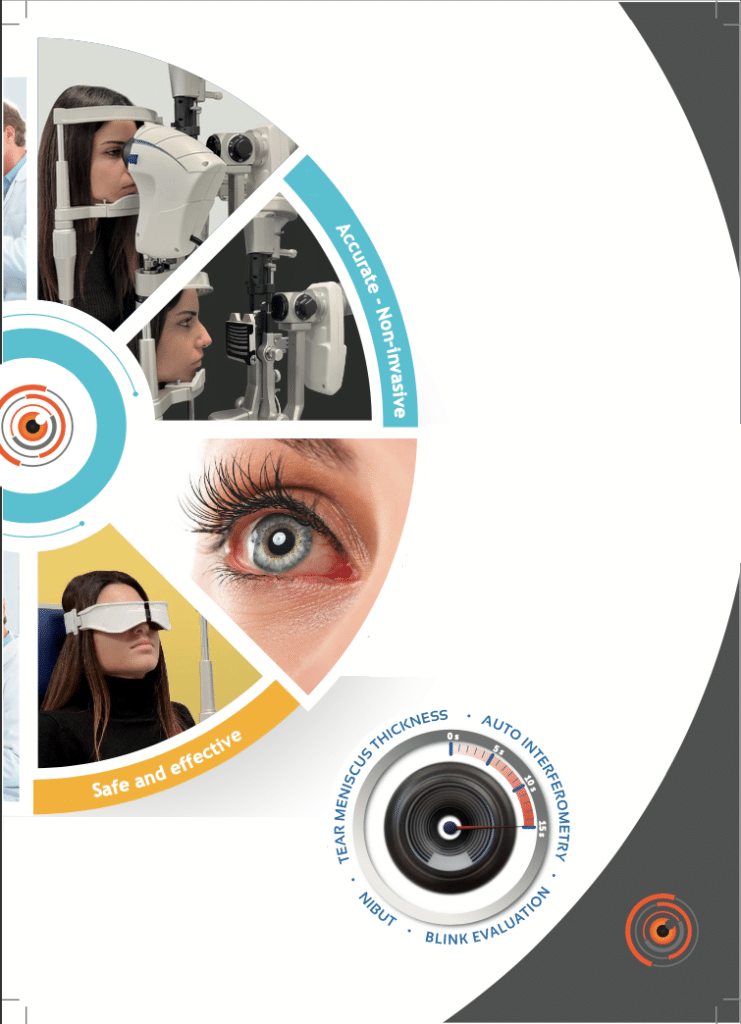
Book for Dry Eye Assessment
Book your Dry Eye Assessment today with a qualified Smart Vision Optometrist.
The assessment of the tear film
During your Dry Eye Assessment, your Smart Vision Optometrist will conduct a thorough examination of all your tear film layers using the latest technology which is completely painless, safe and precise.
What is the tear film?
The tear film is a unique thin fluid layer of approximately 3μm thick and 3μl in volume that covers the outer mucosal surfaces of the eye. As such it is the interface of the ocular surface with the environment.
What is the tear film composed of?
The traditional description of the tear film divides it into three layers: lipid, aqueous and mucin. The role of each layer depends on the composition of it. Tear production, evaporation, absorption and drainage concur to dynamic balance of the tear film and leads to its integrity and stability.
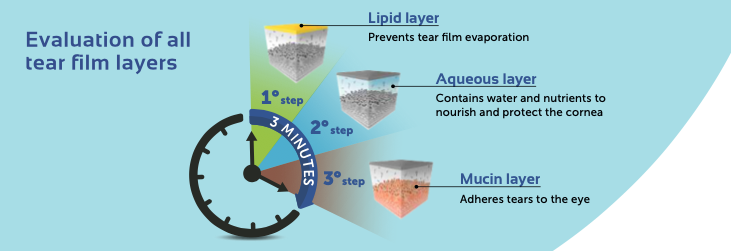
Book Your Dry Eye Assessment Today
With A Qualified Smart Vision Optometrist
Understanding the examination process
Your Smart Vision Optometrist will perform 9 different examinations on your eyes to assess your dry eye condition. This will provide the baseline for when improvements due to Dry Eye Disease treatment will be remeasured and compared. These examinations include:
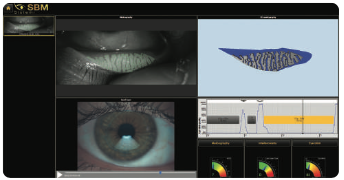
Auto Interferometry
Your Smart Vision Optometrist evaluates the quantity and quality of the lipid component on the tear film.
They highlight the lipid layer to analyse the Lipid Layer Thickness (LLT). They will obtain the relevant data to understand functionality of Meibomian Glands such as average LLT.
Tear meniscus height measurement
Low tear production may result in aqueous tear deficiency (ATD) and cause dry eye symptoms. However, measuring the tear volume is difficult since the methods normally used are invasive and irritating. We evaluate the aqueous layer using the non-invasive ”Tear Meniscus” test and then classify it into different categories.
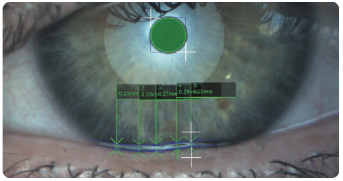

Auto-NIBUT
Your Smart Vision Optometrist will evaluate your tear film stability and regularity, using non-invasive break up time measurement (NI- BUT). This measures the number of seconds between one complete blinking and the appearance of the first discontinuity in the tear film.
Blinking quality
Blinking rate and completeness of blinking are also crucial for wetting the eye adequately. Inefficient blinking may be related to a low blinking rate or incomplete blinking and can often be a reason for dry eye symptoms or ocular surface staining.
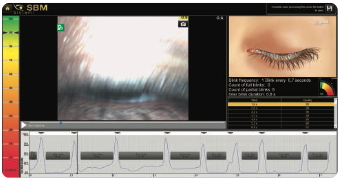
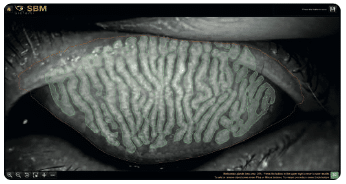
Meibography
Meibomian Glands (MGs) play a significant role in tear quality by producing lipids (meibum) that are part of the superficial tear film. Dysfunction of the MGs destabilises tear composition resulting in evaporative dry eye. MGs are uniquely imaged with infrared technology to assess the physiology and health of these ducts and is performed on your upper and lower eyelids.
Meibography 3D
Your Smart Vision Optometrist will use 3D imaging to observe the Meibomian Gland which provides two big advantages. Firstly, it enables us to confirm the presence of abnormal glands compared to a healthy subject; secondly, it provides a clear image to share with you, to help explain the potential reason of your discomfort.
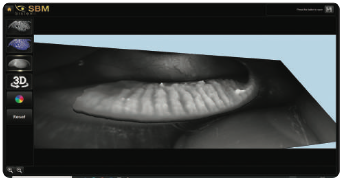
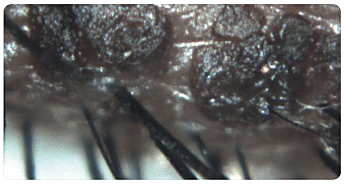
Cylindrical Dandruff and Blepharitis
Blepharitis is an inflammation caused by some bacteria that lie at the base of eyelashes. They produce dandruff-like flakes in the skin, which lead to infection and inflammation. Often blepharitis is a common cause of MG disfunction and dry eye disease.
DEWS Dry Eye Questionnaire
The Dry Eye Questionnaire (DEQ) was created in order to diagnose dry eye disease and to quantify its severity level. Your Smart Vision Optometrist will use this questionnaire to measure several symptoms using four variables: degree of irritation, frequency, intensity in the morning, and intensity late in the day.
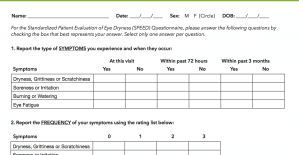
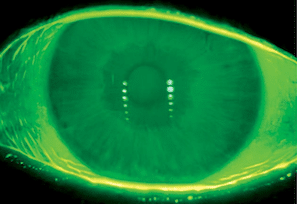
Fluorescein
The fluorescein tear film break-up test is conducted by your Smart Vision Optometrist to test the tear film stability for dry eye diagnosis. This test requires applying fluorescein sodium drops to a tear film to observe the tear film break-up.
Your Smart Vision Optometrist will review the detailed reports and tailor a custom wellness treatment program for you.
Treatment options
The various treatment options include:
Why Choose Smart Vision Optometry?
At Smart Vision Optometry, we are committed to providing comprehensive eye care tailored to each patient. Our Dry Eye Smart Assessment utilises state-of-the-art technology and evidence-based practices to ensure accurate diagnosis and effective treatment.
Our Commitment to Excellence:
- Experienced Optometrists: Our team of skilled professionals is dedicated to your eye health.
- Cutting-Edge Technology: We use the latest diagnostic tools and treatments for optimal results.
- Personalised Care: Every treatment plan is customised to meet your unique needs and lifestyle.
Book Your Dry Eye Assessment Today
With A Qualified Smart Vision Optometrist
Contact Us
For more information or assistance with booking, please contact our Bondi (02) 9365 5047 or Mosman (02) 9969 1600 practice directly. Our friendly staff is here to help with all your myopia prevention and eye care needs.
